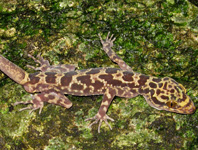Abstract
Land planarians (Tricladida:Geoplanidae) comprise about 910 species distributed in four subfamilies and can be found on all continents except Antarctica (Sluys & Riutort 2018; Sluys 2019). The Neotropical region possesses nearly 31% of all the described terrestrial planarian species, most of them belonging to the subfamily Geoplaninae (Sluys 1999; Grau & Carbayo 2010). Land planarians are mostly habitat-specialists, living in the humid soils of native forest, and predating on invertebrates like earthworms, isopods, mollusks and harvestmen, among others (Ogren 1995; Carbayo & Leal-Zanchet 2003; Boll & Leal-Zanchet 2016). Although most planarian species seem to be physiologically sensitive, for example to environmental moisture, a few land planarian genera like Bipalium Stimpson and Obama Carbayo et al., have successfully invaded many habitats, even in highly perturbed areas (Kawaguti 1932; Sluys 2019). Therefore, some of these invertebrate species appear to be good candidates as habitat quality bioindicators according to some authors (Sluys 1998; Gerlach et al., 2013; Negrete et al., 2014).
References
Aguilera, M.A. (2009) Invertebrados del parque Oncol. In: Almarza, C. (Ed.), Parque Oncol. Geographic Press, Santiago, pp. 218–285.
Alaniz, A.J., Carvajal, M.A., Smith-Ramírez, C., Barahona-Segovia, R.M. & Vieli, L. (2018) Habitat loss of a rainforest specialist pollinator fly as an indicator of conservation status of the South American Temperate Rainforests. Journal of Insect Conservation, 22, 745–755.
https://doi.org/10.1007/s10841-018-0098-0
Barahona-Segovia, R.M. (2019) Conservación biológica de invertebrados en los bosques costeros de Chile: Amenazas y propuestas. In: Smith-Ramírez, C. & Squeo, F. (Eds.), Biodiversidad y Conservación de los bosques costeros de Chile.Editorial Universidad de Los Lagos, Osorno, pp. 269–298
Barahona-Segovia, R.M., Crespin, S.J., Grez, A.A. & Veloso, C. (2019) Anthropogenic thermal gradient in managed landscapes determines physiological performance and explains the edge-biased distribution of ectothermic arthropods. Forest Ecology and Management, 440, 147–157.
https://doi.org/10.1016/j.foreco.2019.03.018
Boll, P.K. & Leal-Zanchet, A.M. (2016) Preference for different prey allows the coexistence of several land planarians in areas of the Atlantic Forest. Zoology, 119, 162–168.
https://doi.org/10.1016/j.zool.2016.04.002
Bulnes, V.N., Grau, J.H. & Carbayo, F. (2018) A new Chilean genus and species of land planarian (Platyhelminthes: Tricladida, Geoplaninae) with cephalic retractor muscle and adenodactyl. Journal of Natural History, 52, 2553–2566.
https://doi.org/10.1080/00222933.2018.1538468
Carbayo, F. & Leal-Zanchet, A.M. (2003) Two new genera of geoplaninid land planarians (Platyhelminthes: Tricladida: Terricola) of Brazil in the light of cephalic specializations. Invertebrate Systematics, 17, 449–468.
https://doi.org/10.1071/IT01035
Carbayo, F., Leal-Zanchet, A.M. & Vieira, E.M. (2002) Terrestrial flatworm (Platyhelminthes: Tricladida: Terricola) diversity versus man-induced disturbance in an ombrophilous forest in southern Brazil. Biodiversity & Conservation, 11, 1091–1104.
https://doi.org/10.1023/A:1015865005604
Cardoso, P., Borges, P.A., Triantis, K.A., Fernández, M.A. & Martín, J.L. (2011) Adapting the IUCN Red List criteria for invertebrates. Biological Conservation, 144, 2432–2440.
https://doi.org/10.1016/j.biocon.2011.06.020
Dauby, G., Stévart, T., Droissart, V., Cosiaux, A., Deblauwe, V., Simo-Droissart, M., Sosef, M.S.M., Lowry II, P.P., Schatz, G.E., Gereau, R.E. & Couvreur, T.L. (2017) ConR: An R package to assist large-scale multispecies preliminary conservation assessments using distribution data. Ecology and Evolution, 7, 11292–11303.
https://doi.org/10.1002/ece3.3704
Gerlach, J., Samways, M. & Pryke, J. (2013) Terrestrial invertebrates as bioindicators: an overview of available taxonomic groups. Journal of Insect Conservation, 17, 831–850.
https://doi.org/10.1007/s10841-013-9565-9
Grau, J.H. & Carbayo, F. (2010) Panorama de la diversidad de planarias terrestres (Platyhelminthes: Tricladida) de Chile. Boletín de Biodiversidad de Chile, 2, 41–54.
Kawaguti, S. (1932) On the physiology of land planarians. III. The problems of desiccation. Memoirs of the Faculty of Science and Agriculture, 7, 39–55.
Negrete, L., Colpo, K.D. & Brusa, F. (2014) Land planarian assemblages in protected areas of the Interior Atlantic Forest: implications for conservation. PloS One, 9, e90513.
https://doi.org/10.1371/journal.pone.0090513
Ogren, R.E. (1995) Predation behaviour of land planarians. Hydrobiologia, 305, 105–111.
https://doi.org/10.1007/978-94-011-0045-8_17
Pauchard, A., Aguayo, M., Peña, E. & Urrutia, R. (2006) Multiple effects of urbanization on the biodiversity of developing countries: the case of a fast-growing metropolitan area (Concepción, Chile). Biological Conservation, 127, 272–281.
https://doi.org/10.1016/j.biocon.2005.05.015
Rojas, C., Pino, J., Basnou, C. & Vivanco, M. (2013) Assessing land-use and-cover changes in relation to geographic factors and urban planning in the metropolitan area of Concepción (Chile). Implications for biodiversity conservation. Applied Geography, 39, 93–103.
https://doi.org/10.1016/j.apgeog.2012.12.007
Schneider, C.O. (1934) Observaciones sobre el Polycladus gayi. Revista Chilena Historia Natural, 38, 56–58.
Semenas, L. (2013) Polycladus gayi, la planaria gigante de la selva Valdiviana. Macroscopia, 3, 18–21.
Sluys, R. (1998) Land planarians (Platyhelminthes, Tricladida, Terricola) in biodiversity and conservation studies. Pedobiologia, 42, 490–494.
Sluys, R. (2019) The evolutionary terrestrialization of planarian flatworms (Platyhelminthes, Tricladida, Geoplanidae): a review and research programme. Zoosystematics and Evolution, 95, 543.
https://doi.org/10.3897/zse.95.38727
Sluys, R. & Riutort, M. (2018) Planarian diversity and phylogeny. In: Rink, J.C. (Ed.), Planarian Regeneration. Humana Press, New York, New York, pp. 1–56.
https://doi.org/10.1007/978-1-4939-7802-1_1


